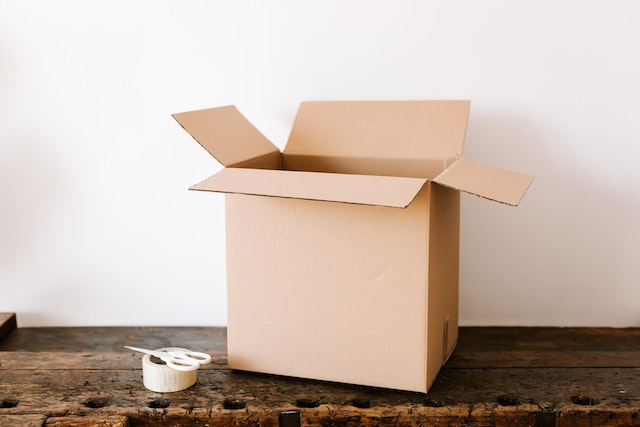
When was corrugated cardboard first used? Corrugated cardboard was first used as a liner for top hats.
Corrugated cardboard is commonly used for making cardboard boxes and if you have ever ordered anything from Amazon, you will have handled some. It consists of a corrugated sheet sandwiched between two linerboards. The corrugated layer gives it far more strength than regular cardboard, making it ideal for packing boxes.
The waves in the corrugated layer are known as fluting and the size and number of flutes can affect the strength of the corrugated cardboard. The reason for this is down to something called Gaussian curvature, named after Carl Friedrich Gauss. Gaussian curvature is the way to measure the amount something curves. Paper is flat, so it has a Gaussian curvature of zero. A basketball has a positive Gaussian curvature and a cylinder that is narrower in the middle than it is at the top (like a diablo) has negative Gaussian curvature. So, what does this have to do with cardboard? Gauss’s theorem is that if the paper is flat and has zero Gaussian curvature, when you bend it, one direction of the paper must always remain flat. This is why you can pick up a floppy piece of pizza if you bend it. The sides curve in, so the long edge has to be flat. When paper is fluted in the center of corrugated cardboard, it is curved on one side, which forces the other side to become stiff, giving cardboard its strength.
The flutes in the corrugated cardboard also have air pockets that cushion whatever is in the box and insulate it.
The first cardboard box was made in 1817. The Industrial Revolution had improved papermaking techniques and it wasn’t too difficult to make thick paper, called paperboard. There are three different sources for paperboard being used to make a box in 1817: a British industrialist called Malcolm Thornhill, a German board game box, and a business called M. Treverton & Son. The fact that all three people used it in the same year could imply that it had been around for a while.
The first corrugated paper was made in 1856 and it was used to line and strengthen top hats. Edward C. Healy and Edward E. Allen, two British milliners, were trying to find a way to support their top hats. They realized that pleating paper made it incredibly strong along the edge that wasn’t curved. They patented their “pleated paper”. It was stronger than a cylinder of paper, it kept the hat’s shape, it was durable, and it provided cushioning. They made it on a collar press.
It took another 44 years before corrugated cardboard was invented. In 1871, American Albert Jones invented single-sided corrugated cardboard and he used it for wrapping bottles. He glued fluted paper onto a piece of paperboard. When he wrapped bottles in it, the cardboard kept its shape, and the fluting gave the bottle much more protection than cloth. Oliver Long improved on it in 1874 by adding another piece of paperboard on the other side as well.
In 1890, Scottish inventor Robert Gair came up with the pre-cut corrugated cardboard box. It actually happened by accident. He had a factory that made paper bags. One machine would cut the bags and another would crease the bags. It was fairly time consuming. On one of the machines, a metal ruler that was used to crease the bags slipped out of place and cut the bags. Gair realized that he could cut and crease at once. He started to cut and crease the new corrugated cardboard that had just been invented and made the first cardboard box factory. His boxes were fairly successful, but it really took off in 1896. The National Biscuit Company started selling Uneeda Biscuits in boxes and they bought their boxes from Gair.
The cardboard box really came into its own in the 1950s when the shipping of fruit and vegetables became more common. Corrugated cardboard is much better at shock absorbing than wood or other packaging, and it protected the fruit, reducing bruising and damage. Because it made the shipping of fruit and vegetables safer, the cardboard box, coupled with refrigeration, could be said to be one of the causes of globalization.
Corrugated cardboard machines can produce 150m of cardboard every minute. The paper is made more flexible with high-pressure steam and then the three pieces are pressed together. And this is what I learned today.
Sources
https://www.wired.com/2014/09/curvature-and-strength-empzeal/
https://www.packsize.com/blog/corrugated/where-does-corrugated-cardboard-get-its-strength/
https://en.wikipedia.org/wiki/Corrugated_fiberboard
https://www.dssmith.com/tecnicarton/about/newsroom/2018/11/the-origin-of-corrugated-cardboard
http://www.kirkhambox.co.uk/History.html
https://www.jkmoving.com/blog/residential-moving/how-much-weight-can-a-cardboard-box-hold-for-moving
https://boingboing.net/2014/09/06/deep-math-of-the-folded-pizza.html
https://www.wired.com/2014/09/curvature-and-strength-empzeal/
https://www.packsize.com/blog/corrugated/where-does-corrugated-cardboard-get-its-strength/
